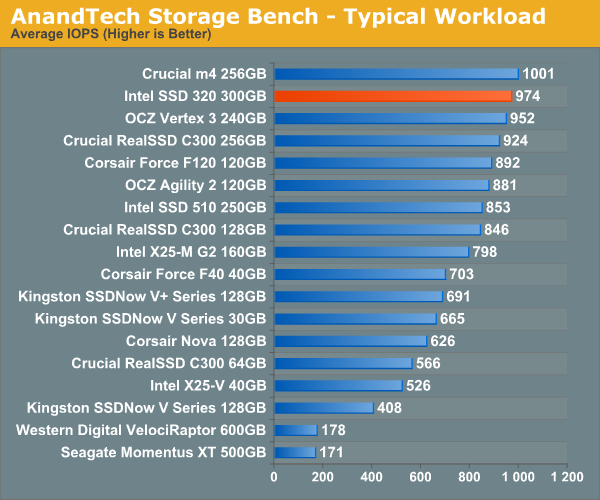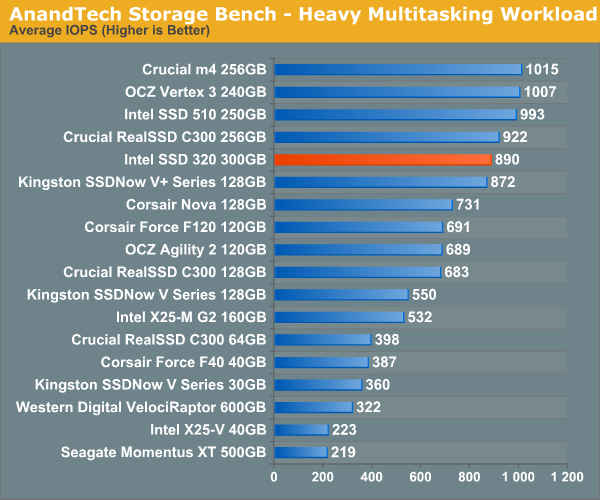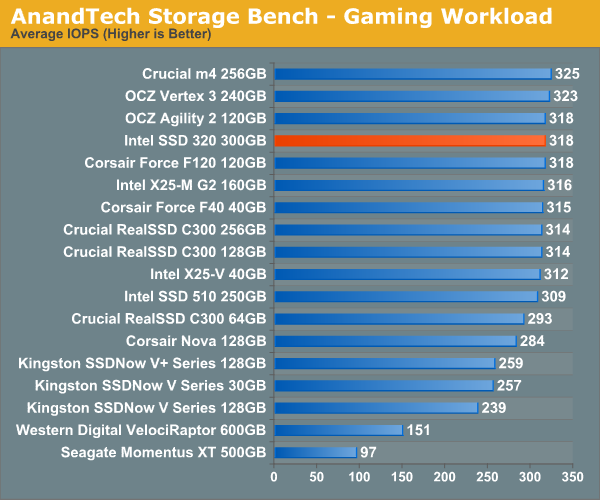The Intel SSD 320 Review: 25nm G3 is Finally Here
by Anand Lal Shimpi on March 28, 2011 11:08 AM EST- Posted in
- IT Computing
- Storage
- SSDs
- Intel
- Intel SSD 320
AnandTech Storage Bench 2010
To keep things consistent we've also included our older Storage Bench. Note that the old storage test system doesn't have a SATA 6Gbps controller, so we only have one result for the 6Gbps drives.
The first in our benchmark suite is a light/typical usage case. The Windows 7 system is loaded with Firefox, Office 2007 and Adobe Reader among other applications. With Firefox we browse web pages like Facebook, AnandTech, Digg and other sites. Outlook is also running and we use it to check emails, create and send a message with a PDF attachment. Adobe Reader is used to view some PDFs. Excel 2007 is used to create a spreadsheet, graphs and save the document. The same goes for Word 2007. We open and step through a presentation in PowerPoint 2007 received as an email attachment before saving it to the desktop. Finally we watch a bit of a Firefly episode in Windows Media Player 11.
There’s some level of multitasking going on here but it’s not unreasonable by any means. Generally the application tasks proceed linearly, with the exception of things like web browsing which may happen in between one of the other tasks.
The recording is played back on all of our drives here today. Remember that we’re isolating disk performance, all we’re doing is playing back every single disk access that happened in that ~5 minute period of usage. The light workload is composed of 37,501 reads and 20,268 writes. Over 30% of the IOs are 4KB, 11% are 16KB, 22% are 32KB and approximately 13% are 64KB in size. Less than 30% of the operations are absolutely sequential in nature. Average queue depth is 6.09 IOs.
The performance results are reported in average I/O Operations per Second (IOPS):

If we strip 6Gbps out of the equation completely, the SSD 320 does very well in our old light workload. You're looking at performance that's at the top of the pack from the mainstream offering.
If there’s a light usage case there’s bound to be a heavy one. In this test we have Microsoft Security Essentials running in the background with real time virus scanning enabled. We also perform a quick scan in the middle of the test. Firefox, Outlook, Excel, Word and Powerpoint are all used the same as they were in the light test. We add Photoshop CS4 to the mix, opening a bunch of 12MP images, editing them, then saving them as highly compressed JPGs for web publishing. Windows 7’s picture viewer is used to view a bunch of pictures on the hard drive. We use 7-zip to create and extract .7z archives. Downloading is also prominently featured in our heavy test; we download large files from the Internet during portions of the benchmark, as well as use uTorrent to grab a couple of torrents. Some of the applications in use are installed during the benchmark, Windows updates are also installed. Towards the end of the test we launch World of Warcraft, play for a few minutes, then delete the folder. This test also takes into account all of the disk accesses that happen while the OS is booting.
The benchmark is 22 minutes long and it consists of 128,895 read operations and 72,411 write operations. Roughly 44% of all IOs were sequential. Approximately 30% of all accesses were 4KB in size, 12% were 16KB in size, 14% were 32KB and 20% were 64KB. Average queue depth was 3.59.

Crank up the workload and the 320 falls a bit behind the rest of the competitors. Last year's heavy multitasking workload is nothing compared to what we introduced earlier this year, so it's still pretty light by comparison but it's clear for normal usage the 320's 3Gbps performance is quite good.
The gaming workload is made up of 75,206 read operations and only 4,592 write operations. Only 20% of the accesses are 4KB in size, nearly 40% are 64KB and 20% are 32KB. A whopping 69% of the IOs are sequential, meaning this is predominantly a sequential read benchmark. The average queue depth is 7.76 IOs.











194 Comments
View All Comments
LeTiger - Monday, March 28, 2011 - link
If Intel's not careful... they will price and performance themselves out of the very market they sought to create in the first place...nexox - Monday, March 28, 2011 - link
Meh, this is the cheapest SSD with some form of capacitor backup for volatile data - to get something similar you need to go to a SandForce 1500 or 2500 controller, and probably expect to pay 2-3x as much. Most people aren't too concerned with this, but it's an essential feature, no matter what the manufacturers say.It's also the only SSD I've seen that doesn't exhibit random latency spikes, that combined with the power fail protection means that it's the only SSD I'd consider buying.
cactusdog - Tuesday, March 29, 2011 - link
At least with Intel you are guaranteed to get best quality nand and reliable performance over the long term. Intel have also done the right thing by rebranding 25nm drives, even though in Intel's case performance is a little better than their 34nm drives.With OCZ, theres no way of knowing which nand you will get and you could end up with second rate nand not intended for high performance SSD's.
Intel's performance is very reliable over the long term, whereas OCZ/sandforce 3GB/s drives are known to slow to a "settled state" especially with smaller drives.
Intel will sell plenty of these drives because they are reliable and trustworthy.
Griswold - Tuesday, March 29, 2011 - link
Exactly. Not everybody plays benchmarks all day long and doesnt care one bit about reliability of the storage system.wumpus - Tuesday, March 29, 2011 - link
And just how many filesystems automatically write everything the instant write() is called? It is a bad idea for rotating media, and will take awhile before filesystems optimized for SSDs show up (Microsoft has been promising a database centric filesystem for the "next windows" since NT was new. Maybe someday.) Also, NTFS has corruption issues with standard hard drives, this isn't going to help that reliability much anyway. You need backups, a real UPS, and RAID (in roughly that order) if you care about data reliability.If intel was willing to compete largely on reliability, they could double the price (if data on SRAM competition is even more expensive), as such a feature is worth much more than any amount of hardware cost to a large number of customers. Don't expect to get it without major software surgery (and yes, some of those customers have the software).
seapeople - Tuesday, March 29, 2011 - link
I don't understand all the negative feedback on this drive. For the 90% of us who have 3Gbps SATA, compared to the Vertex 3 this drive is:~25% slower than Vertex 3
~20% cheaper than Vertex 3
Why is that so terrible, the Vertex 3 is an amazing performance feat, and under common mainstream conditions this drive is about equal on a price/performance basis.
Meanwhile, this drive gives us 20% more performance than the g2 generation while being ~20% cheaper. This is far from sad.
dagamer34 - Tuesday, April 5, 2011 - link
Except the MSRP for a 120GB Vertex 3 is cheaper than what an equally sized Intel SSD 320 series drive costs. That's simply laughable. Higher price for worse performance? Throwing up the "reliability" card is a red herring when you consider that the 25nm process is brand new, you don't get to state that for any technology until it's been around on the market for quite some time (otherwise, it's just name recognition only, and that worked so well for Sandy Bridge chipsets).seapeople - Thursday, April 7, 2011 - link
You're on crack. A 120 GB Vertex 3 is listed as 249.99 versus 209.00 for the 120 GB Intel SSD 320.Furthermore, SSD reliability issues generally arise from controller/firmware nuances and bugs, not the new process node. It sounds like the SSD 320 is basically the g2 with new flash and a few features unlocked, so it's reasonable to expect similar controller reliability. Apart from that, basically everyone uses the same flash anyway, so if the Intel drive dies because of the new flash process then so will the Vertex.
andreyu - Thursday, July 21, 2011 - link
1. you're blind or on crack2. you bought a ocz/corsair ssd cause you wanted speed but returned it for problems and now you're mad on intel?
3.so sorry 4 u
120 GB Intel SSD 320 is CHEAPER than 120 GB Vertex 3
TonyB - Monday, March 28, 2011 - link
lol